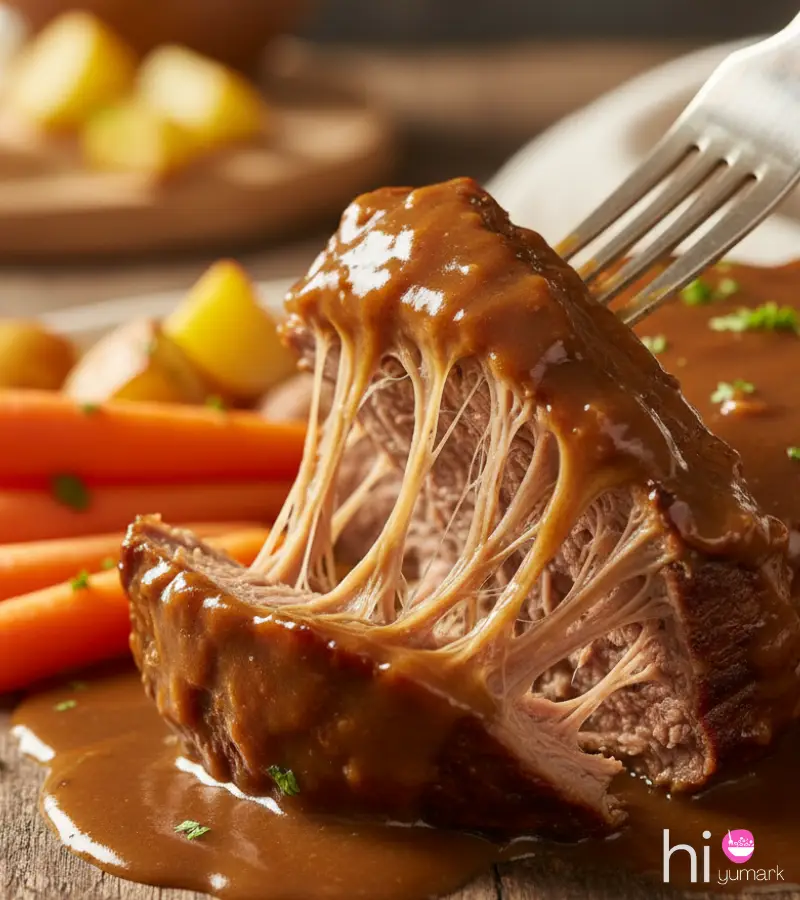The Amish pot roast is all about low-and-slow cooking: season a chuck roast, sear it, then braise with carrots, potatoes, and broth at 325°F for 3–4 hours until it’s fork-tender. Add a quick gravy and you’ve got a hearty, no-fuss dinner that works in the oven, slow cooker, or Instant Pot.
Let’s cut right to it: Amish pot roast = big hunk of beef cooked low and slow until it basically falls apart when you look at it. It’s hearty, unfussy, and the kind of Sunday dinner that fills the house with “Oh wow, what’s cooking?” vibes.

You don’t need fancy spices or a Dutch oven that costs more than your first car. What you do need? Patience, the right cut of beef, and a few smart moves to keep it from turning into dry shoe leather. That’s what this guide is for.
If this recipe has you craving more hearty flavors, check out our collection of Amish main dishes that are just as satisfying.
What You’ll Actually Throw in the Pot?
Forget grocery lists that look like novels. Here’s what matters:
- Beef roast: Chuck roast is king. Brisket works if you want richer flavor, round if you’re on a budget (but it can get drier).
- Veggies: Carrots, potatoes, onions. That’s your holy trinity. Celery is optional.
- Seasoning: Salt, black pepper, garlic, onion, bay leaf. Simple, but don’t be shy with the salt.
- Liquid: Beef broth for body. Amish kitchens often splash in coffee or tomato paste for depth.
- Thickener (for gravy): Flour or cornstarch slurry. Don’t wing it—pick one.
No rosemary sprigs, no wine reductions. This is farmhouse cooking, not a cooking show audition.
Step 1: Prep Like You Mean It
Dry that beef. Wet meat won’t brown, and brown = flavor. Grab paper towels and pat it down like you’re prepping it for prom photos.
Generously season every side with salt and pepper. Not “a sprinkle.” Think “snowstorm.” Salt penetrates deep during a long cook, and under-seasoned pot roast is tragic.
Step 2: The Sear Nobody Wants to Do (But should)
Here’s the hill I’ll die on: always sear your roast first. A few minutes per side in a hot pan builds that deep, savory crust. Skip it and your pot roast tastes like boiled beef.
Yes, it’s an extra pan to wash. No, you can’t replicate it by “just cooking longer.”
Step 3: Load Up the Flavor Base
Lay the roast in your Dutch oven or slow cooker. Scatter onions, carrots, and potatoes around it like little bodyguards. Toss in garlic and a bay leaf.
Pour in enough broth to come about halfway up the meat. You’re braising, not boiling. Amish cooks sometimes add coffee here—it’s not weird. Coffee deepens the gravy without tasting like a latte.
Step 4: Lock It Down and Go Low
Cover tight with a lid or foil. Then let the oven do its thing:
- Oven method: 325°F for 3–4 hours.
- Slow cooker: 8 hours on low (4 on high if you’re impatient).
- Instant Pot: 60–70 minutes, natural release.
Low and slow breaks down the connective tissue, turning tough chuck into tender strands of beefy glory.
So, Which Way’s Best?
| Method | Time | Texture/Flavor | Best Use |
| Oven | 3–4 hrs @ 325°F | Deep flavor, crispy edges | Classic Sunday dinner |
| Slow Cooker | 8 hrs low / 4 high | Super tender, no crust | Workdays, hands-off cooking |
| Instant Pot | 60–70 mins | Juicy, less browning | Weeknights, fast results |
My pick? Oven, every time. That crust from slow braising in a heavy pot is unbeatable.
Step 5: When Is It Actually Done?
Here’s the test: stick a fork in it. If the roast shreds easily, you’re golden. If it fights back, it’s not ready. Don’t crank the heat—just keep cooking.
Don’t Skip the Rest
Pull the roast out and let it sit 10–15 minutes before slicing. This isn’t just for steaks – resting keeps the juices in the meat, not pooling on your plate.
Let’s Talk Gravy (Because That’s Half the Point)
Strain the cooking liquid, skim off excess fat, and whisk in a flour or cornstarch slurry. Simmer until it coats the back of a spoon.
Flour vs cornstarch:
| Thickener | Result | When to Use |
| Flour | Rich, slightly cloudy | Traditional pot roast |
| Cornstarch | Glossy, silkier finish | Gluten-free or lighter gravy |
Variations That Actually Work
- Root swap: Try parsnips or turnips for a rustic twist.
- Noodle night: Skip potatoes, serve over Amish buttered noodles.
- Tomato base: Add tomato paste + crushed tomatoes for a tangier gravy.
- Coffee base: Amish classic—adds depth without tasting bitter.
The Oops Fix-It Guide
- Meat’s tough: You undercooked. Put it back in with more broth and keep going. Time fixes everything.
- Veggies mushy: Add them halfway next time, or cut them in bigger chunks.
- Too salty: Balance with unsalted broth, a splash of cream, or plain mashed potatoes on the side.
- Gravy watery: Thicken with a quick slurry—don’t panic.
Pro Moves That Make You Look Like a Kitchen Boss
- Use a heavy Dutch oven. Thin pans = hot spots and uneven cooking.
- Don’t open the lid every 20 minutes. You’re just letting heat escape.
- Cut veggies into big chunks so they don’t dissolve.
- Make it a day ahead—the flavors deepen overnight.
Frequently Asked Questions
Do I Have to Sear It?
Technically no, but skipping the sear means you’ll lose out on that deep, rich flavor. Searing caramelizes the surface of the meat and creates a base that makes the gravy taste incredible.
If you don’t sear, the beef will cook fine, but the end result will be closer to “boiled beef” in taste and appearance. Even a quick two-minute sear per side makes a huge difference.
What’s The Best Cut?
Chuck roast is the gold standard for pot roast. It has the right balance of marbling and connective tissue that breaks down into tender, juicy bites after long cooking.
Brisket and round roast also work, but chuck consistently delivers the richest flavor. Avoid lean cuts, because they can dry out and end up stringy instead of fork-tender.
Can I Make It Without Potatoes?
Yes, absolutely. If you want a lighter version, swap in egg noodles or rice – they soak up the gravy beautifully.
Some people even use buttered bread on the side to mop up the sauce. If you’re low-carb, try cauliflower chunks; they hold their shape surprisingly well and absorb flavor without turning mushy.
Do I Peel the Carrots?
Not unless you want a very polished look. Rustic style is perfectly fine with just a good wash and trim.
Peeling does give a smoother texture and slightly sweeter flavor, but leaving the skin on keeps nutrients intact and gives the dish that down-home, hearty vibe. Think of it as personal preference – both ways taste great.
Can I Freeze It?
Yes, pot roast freezes well. The best method is to slice the meat into portions first and freeze it with some of the gravy in an airtight container. That way, the meat stays moist when reheated.
Potatoes don’t always reheat perfectly – they can get grainy – so some cooks prefer to freeze just the beef and carrots, then make fresh potatoes later. Properly stored, it’ll last up to 3 months in the freezer.
What to Serve Alongside?
Pot roast feels complete when served with traditional Amish sides. Think buttered noodles soaking up gravy, fluffy mashed potatoes with a pat of butter, or thick slices of fresh-baked bread.
Add steamed green beans or roasted carrots to bring in some freshness, and you’ve got a plate that balances hearty with wholesome.
Leftovers are where pot roast shows its versatility. Shredded beef makes rich sandwiches, quick tacos, or can be tossed into soups and stews. Cold pot roast sandwiches, especially with mustard or pickles, are rustic classics that taste even better the next day.
| Traditional Pairings | Creative Leftovers |
| Buttered noodles | Shredded beef sandwiches |
| Mashed potatoes | Beef tacos with toppings |
| Fresh bread | Hearty soups or stews |
| Roasted vegetables | Cold pot roast sandwiches |
Storage That Won’t Ruin It
For short-term storage, keep leftovers in an airtight container in the fridge. They’ll stay good for 3–4 days. Add a spoonful of gravy when reheating to keep the beef moist.
- Fridge: 3–4 days
- Tip: Reheat with gravy or broth
For longer storage, slice or shred the roast, portion it, and freeze for up to 3 months. Thaw overnight in the fridge. Reheat gently on the stovetop or in the oven for best results. Microwave works, but the texture won’t be as good.
- Freezer: Up to 3 months
- Reheat: Oven or stovetop preferred
Why This Recipe Works Every Time?
It’s not magic – it’s method. Right cut, proper sear, low-and-slow cook. Do those three, and you’ll never serve chewy beef again.
No Pinterest fail, no mystery spices, no drama. Just beef, veg, and time. Exactly how it should be.
Related Recipes:
Amish Pot Roast Recipe
Course: Main CourseCuisine: AmericanDifficulty: Easy6
servings15
minutes3
hours450
kcal3
hours15
minutesSimple, hearty Amish-style pot roast that’s fork-tender and full of flavor - chuck roast braised with carrots, potatoes, and savory gravy.
Ingredients
3 lb chuck roast (or brisket/round)
Salt (generous), black pepper
3 carrots, peeled and halved
4 potatoes, cut in chunks
1 onion, quartered
2 cups beef broth (plus coffee or tomato paste optional)
1 bay leaf
For gravy: flour or cornstarch slurry
Directions
- Pat roast dry and season all over generously with salt and pepper.
- Sear roast in a hot pan until deeply browned on all sides.
- Place roast in Dutch oven or slow cooker; surround with onions, carrots, and potatoes.
- Add broth (and coffee/tomato paste, if using) until it reaches halfway up the meat; toss in bay leaf.
- Cover and cook:
Oven: 325°F for 3–4 hours
Slow cooker: low for 8 hrs (or high for 4 hrs)
Instant Pot: 60–70 min with natural release - Test doneness: roast should shred easily with a fork.
- Rest roast 10–15 minutes before slicing.
- Make gravy: strain cooking liquid, skim fat, whisk in flour or cornstarch slurry, and simmer until thickened.
Recipe Video
Notes
- Searing is essential for building flavor. Dry the roast well before seasoning so it browns instead of steaming. Keep the heat low and give it time to become tender.
